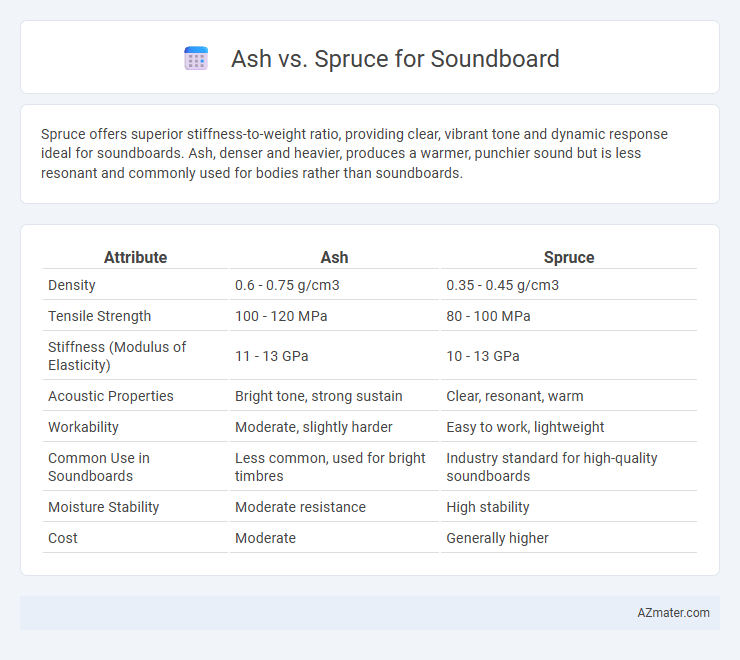Spruce offers superior stiffness-to-weight ratio, providing clear, vibrant tone and dynamic response ideal for soundboards. Ash, denser and heavier, produces a warmer, punchier sound but is less resonant and commonly used for bodies rather than soundboards.
Table of Comparison
| Attribute | Ash | Spruce |
|---|---|---|
| Density | 0.6 - 0.75 g/cm3 | 0.35 - 0.45 g/cm3 |
| Tensile Strength | 100 - 120 MPa | 80 - 100 MPa |
| Stiffness (Modulus of Elasticity) | 11 - 13 GPa | 10 - 13 GPa |
| Acoustic Properties | Bright tone, strong sustain | Clear, resonant, warm |
| Workability | Moderate, slightly harder | Easy to work, lightweight |
| Common Use in Soundboards | Less common, used for bright timbres | Industry standard for high-quality soundboards |
| Moisture Stability | Moderate resistance | High stability |
| Cost | Moderate | Generally higher |
Introduction to Soundboard Tonewoods
Ash and spruce are prominent tonewoods used for guitar soundboards, each contributing distinct tonal characteristics. Spruce, known for its lightweight and tight grain, delivers a bright, clear, and dynamic sound with excellent projection, making it the preferred choice for many acoustic guitars. Ash offers a balanced tone with pronounced midrange and a strong sustain, often favored in electric guitar bodies but less common as a soundboard material due to its heavier density.
Characteristics of Ash Wood
Ash wood, favored for soundboards, offers exceptional strength and flexibility, contributing to bright, clear tone production with enhanced resonance. Its open grain structure allows for efficient sound vibration transmission, resulting in excellent projection and sustain. The wood's balanced density and hardness also provide durability without compromising tonal quality, making it ideal for dynamic soundboards in musical instruments.
Characteristics of Spruce Wood
Spruce wood, commonly used for soundboards in guitars and other stringed instruments, is prized for its lightweight and exceptional strength-to-weight ratio, which contributes to superior resonance and sound projection. Its fine, even grain structure allows for efficient vibration transfer, producing a bright, clear tone with excellent dynamic range. Spruce's responsiveness and ability to enhance harmonic overtones make it a preferred choice for players seeking both volume and tonal complexity.
Acoustic Properties: Ash vs Spruce
Spruce soundboards are renowned for their exceptional strength-to-weight ratio, producing bright, clear tones with excellent resonance and dynamic range favored in acoustic guitars. Ash, while less common for soundboards, offers a slightly warmer and more midrange-focused sound, with a tighter grain that can enhance sustain but generally provides less top-end sparkle than spruce. The choice between ash and spruce impacts tonal brightness, projection, and response, with spruce highly preferred for its balanced clarity and ash valued for its distinctive warmth and sustain characteristics.
Density and Resonance Comparison
Ash exhibits a density ranging from 0.60 to 0.75 g/cm3, providing a bright and snappy resonance that enhances attack and clarity in soundboards. Spruce, with a lower density between 0.35 and 0.45 g/cm3, offers superior resonance and sustain due to its lighter, more elastic fibers, making it the preferred choice for detailed harmonic response. The denser ash produces a punchier tone with strong projection, while spruce delivers a warm, balanced sound characterized by rich overtones and rapid decay.
Visual Aesthetics and Grain Patterns
Ash soundboards display a bold, pronounced grain with contrasting light and dark streaks, creating a visually striking and dynamic appearance ideal for rustic or vintage-style guitars. Spruce soundboards feature a fine, straight grain with a more uniform and subtle aesthetic, emphasizing elegance and simplicity that complements contemporary and classical instrument designs. Both woods enhance visual appeal uniquely, with ash offering dramatic texture and spruce providing refined, consistent patterns favored by luthiers.
Durability and Longevity
Ash soundboards are prized for their exceptional durability and impact resistance, making them ideal for instruments or audio devices requiring long-lasting performance. Spruce, although softer than ash, offers a balanced combination of strength and flexibility with remarkable longevity when properly maintained, contributing to its popularity in high-quality soundboards. Both woods provide durable options, but ash typically outperforms spruce in withstanding physical wear over time.
Suitability for Different Musical Styles
Ash soundboards provide a bright, punchy tone ideal for rock, blues, and genres requiring strong attack and sustain, enhancing percussive playing styles. Spruce offers a more balanced, resonant sound with greater dynamic range, making it suitable for classical, folk, and acoustic styles demanding clarity and warmth. Guitarists seeking versatility often prefer spruce for its responsiveness, while ash suits players favoring aggressive, cutting tones.
Cost and Availability
Ash soundboards typically cost less than spruce due to the ash wood's wider availability and faster growth rate, making it a budget-friendly option for instrument makers. Spruce remains the industry standard for soundboards due to its superior tonal qualities, but scarcity and slower growth contribute to higher prices and limited availability. Choosing ash can significantly reduce expenses without sacrificing durability, although the tonal performance may not match that of premium spruce.
Conclusion: Choosing the Right Soundboard Wood
Ash offers a bright, punchy tone with excellent midrange clarity, making it ideal for dynamic soundboards in electric guitars and drums. Spruce provides superior resonance and sustain due to its lightweight, tight grain structure, favored in acoustic instruments prioritizing rich, balanced sound. Selecting the right soundboard wood depends on the desired tonal qualities and application, with ash preferred for punch and clarity and spruce for warmth and projection.

Infographic: Ash vs Spruce for Soundboard
 azmater.com
azmater.com